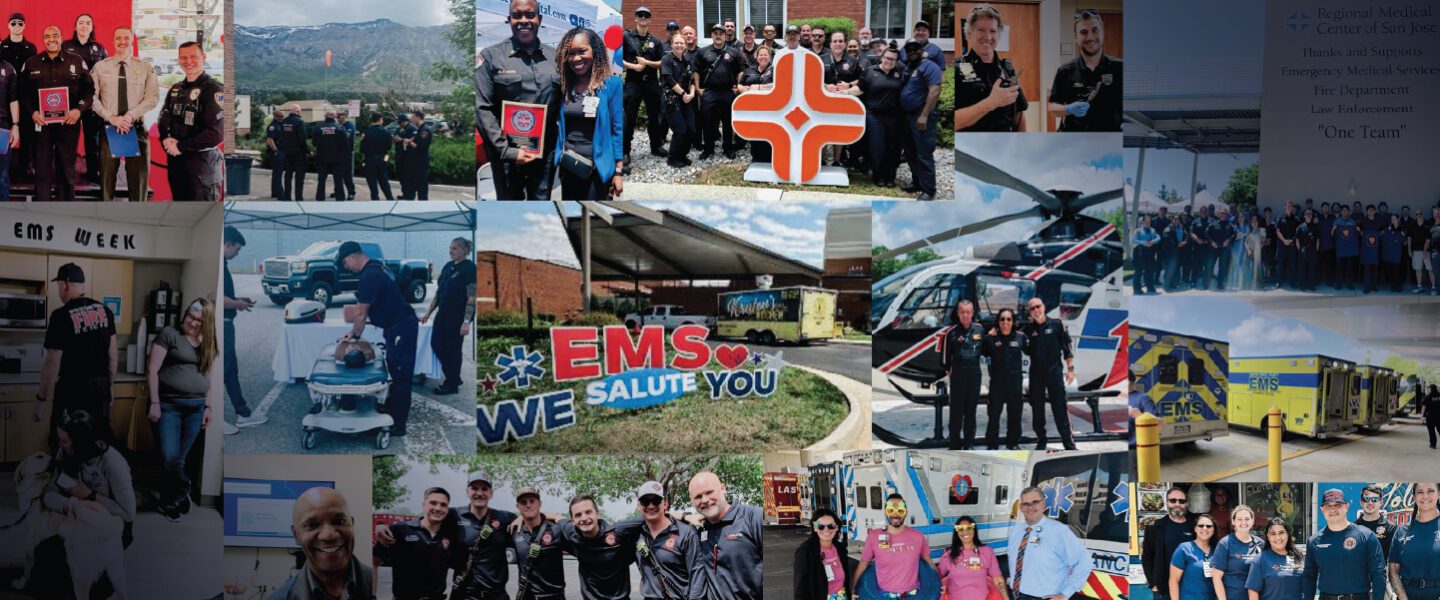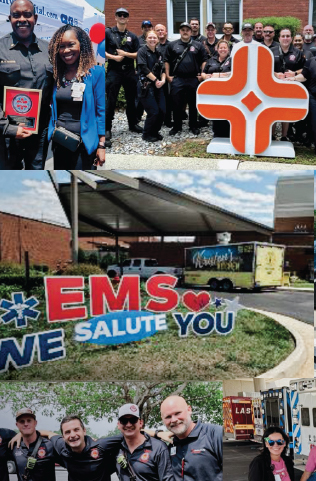Close collaboration with EMS agencies elevates HCA Healthcare’s care and presence in our communities.


HCA Healthcare strives to be patients’ and care providers’ choice when they make a life-or-death decision about where to go for patient care. In 2023, HCA Healthcare served 9.3 million emergency room patients. More than 1.6 million of those patients were delivered by emergency medical services (EMS).

Erica Rossitto, senior vice president and assistant chief nursing executive based in Nashville, helped lead emergency room revitalization efforts, which became a companywide priority initiative in early 2023.
“EMS has always been a key partner in our emergency rooms and a critical part of our emergency care team,” Erica says.
In addition to valuing EMS as external care partners, HCA Healthcare compliantly supports continuing education for EMS providers in their communities. HCA Healthcare also employs EMTs and paramedics in emergency rooms as part of ER care teams.
“We’ve done a lot of work to enhance the role of the paramedic in our ER so that they can function at the top of their license and be a valued part of that care team alongside nurses and physicians,” Erica says.
Revitalizing ERs
The COVID-19 pandemic significantly changed ERs across the country. As COVID cases surged throughout the pandemic, emergency rooms often became alternative care spaces to accommodate overflow and inpatients, in addition to caring for ER patients. Erica says the pandemic dismantled many of the systems of control and processes that were used to manage emergency rooms.
“We utilized the geography of our emergency rooms for different purposes in the pandemic,” Erica says. “It completely changed where supplies were located, how care teams were organized, how process flows were mapped, how technology was used. It impacted the stability of our leadership teams, our workforce. Our ERs didn’t function as pure HCA Healthcare ERs through the pandemic. We had to rebuild our teams and systems.”
At the close of 2022, HCA Healthcare leaders began discussing ways to stabilize ERs and reinstate the level of operations that were in place pre-pandemic.
A focus on throughput
After extensive work and collaboration, the HCA Healthcare ER and EMS playbook now helps guide emergency room teams to their pre-pandemic efficiencies.
“It addresses things like how we receive and greet EMS when they arrive, how quickly we assume care of the patients they are transporting. How do we close the loop with them on the care that we provided to the patients entrusted to our care?” Erica says. “It guides how we create space conducive to their workflow so that they can quickly return to serving the community.
Included in the playbook are key metrics and expectations. The EMS Implementation Plan offers a chronological list of tasks for building relationships and monitoring staff performance related to EMS partners. An EMS staffing tool calculates the need for dedicated or shared resources within a facility or division to support EMS relationships. The playbook even includes EMS lounge standards.
Respect and responsiveness are key to successful ER and EMS partnerships. Erica says HCA Healthcare ER teams understand the importance of collaborating with the EMS provider’s role.
“We make sure we’re responsive. We make sure that we’re ready when they show up, and we make sure that they are greeted and treated with respect in our emergency rooms,” she says.
One area of focus is what’s called the assumption of care, or the time it takes to transfer the care of a patient from the EMS provider upon arrival to a nurse or HCA Healthcare provider. As of July 2024, HCA Healthcare emergency rooms showed the average time of transfer to be about eight minutes.
“That’s a badge of honor for us that you, as a critical EMS provider, can show up in an HCA Healthcare facility and we will get you in and out in under eight minutes, allowing you to help someone else,” Erica says. “That’s a key differentiator for us. That we are highly clinically capable, paired with our ability to get you back out in the community as soon as possible.”
EMS has always been a key partner in our emergency rooms and a critical part of our emergency care team.— Erica Rossitto, Senior Vice President and Assistant Chief Nurse Executive, Chief Nurse Executive, HCA Atlantic Group, HCA Healthcare, Clinical Services Group
HCA Healthcare has more than 80 EMS directors and liaisons across the company. Some HCA Healthcare hospital CEOs and other executives also ride along with EMS providers to get firsthand experience of what their day is like.
Focused efforts to strengthen EMS partnerships have seen success. Last year, HCA Healthcare composed a standardized EMS survey for the first time and distributed it to more than 3,000 agencies. The surveys were directed to EMS and leadership teams and elicited more than 3,800 responses. Results from 10 of 15 divisions showed that 82% of EMS providers would recommend an HCA Healthcare ER to a friend or family in need of care. Additionally, 88% rated their interactions with
HCA Healthcare physicians and nurses favorably.
“It shows that they trust us, and they trust the care we provide. They also have a positive experience when they interact with an HCA Healthcare nurse or physician in one of our ERs,” says Amy Casseri, SVP of Physician and Provider Relations.
“We work closely with EMS teams through ongoing training, collaborative protocols and open communication channels to ensure seamless transitions of care. By maintaining this strong partnership, we not only improve patient outcomes but also continue to uphold the trust that our community places in us,” says Todd Sklamberg, CEO Sunrise Hospital and Medical Center.
“Together, we are dedicated to saving lives and enhancing the health and well-being of those we serve.”


